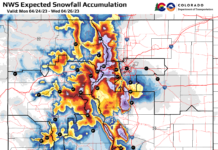
by Christy Parrott
In the mid 80s, Kevin Kaltenbaugh read an article about packing in the backcountry with llamas and found himself completely fascinated. “In my early thirties, a hundred pound pack really started taking its toll on my knees,” Kaltenbaugh explains. The llamas changed all that. “With the llamas, I can still walk twelve to fifteen miles in rough country,” Kaltenbaugh says. Going deeper into the backcountry with assistance can make all the difference when hunting and, with any luck, packing out game. “Like most hobbies,” Kaltenbaugh admits, “It got completely out of control.” What had once been a private interest has grown to a year-round business: Corral Creek Llamas.
Llamas are extremely friendly for beginners, “Because they’re not intimidating animals,” Kaltenbaugh explains. Llamas are easy to handle on the trails, and you can put three in the back of an open-bed pickup. “You’ll get a lot of looks at the gas station,” Kaltenbaugh grins. Daily trips are $50, and week-long trips are $200 in the summer and $300 in the winter, due to high demand. Corral Creek typically carries 60-70 llamas just to cover the first rifle season.
Llamas excel at backcountry trecks because they aren’t affected by the cold. They can tolerate forty below, Kaltenbaugh insists, “So negative thirty is no big deal.” Moreover, the animals have the lightest impact on the environment. Unlike horses, mules and pack goats (the latest fad), llamas don’t carve up even the muddiest trails and require little food support. Unless there’s a heavy snow, llamas feed on top of the pack, so they won’t dig into the trails. The only caveat is that llamas prefer to hit the trail around five or six am, so they get to their destination as the day begins to warm (though they only truly suffer once the temperature reaches 85-90 degrees). Their ease of care in the backcountry makes them more than worth it. Clients need only a corkscrew in the ground, like those used for the family dog, and when the circle of groundcover gets eaten, simply move the corkscrew. Llamas require exposure to water just once a day, and they thrive above treeline, eating whatever nature provides them. “They fill a niche,” Kaltenbaugh explains, but he insists there’s “No bad animal that can relieve a burden.”
Kaltenbaugh has a 90% success rate with training llamas, which begin training at one year and are usually ready for the trails by age three. The business has crashed twice but is currently enjoying its most successful season. “Every year backpacking doubles,” Kaltenbaugh says. While hunters will typically lease out a two-week timeframe, families with small children can book day trips. “Elliot’s Ridge is a perfect summer day for a beautiful walk with a young llama,” Kaltenbaugh says. Couples are even renting out the pack animals for their weddings. “This is the first year we rented the llamas for a wedding ceremony at Silver Creek,” Kaltenbaugh laughs. “The lamas thought the bouquet looked really tasty.” Corral Creek Llamas is located six miles east of Kremmling on highway 40. For more information call 970-531-0555.








